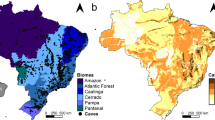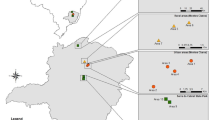Abstract
The common Mediterranean ruderal thistleSilybum marianum is associated with nutrient-rich sites. Its wind-dispersed achenes possess an oily food body, that is attractive to harvester-ants. Following removal of the oily body, the achenes are deposited in the refuse zone together with rich organic material and soil removed from the nest; while in the nest the achenes are partly protected from fires. The thistle grows successfully in the nutrient-enriched refuse zone and thus dominates patches in the grassland. Preadaptations to live in association with harvester-ants enableS. marianum to occur also on marking stations of male gazelle, on cattle dung deposits, and in synanthropic ruderal habitats.
Similar content being viewed by others
References
Avidov, Z., 1968: Harvester ants in Israel. — Tel Aviv: Sifriath Hassadeh. (In Hebrew).
Barbour, M. G., Burk, W. D., Pitts, W. D., 1987: Terrestrial plant ecology. 2nd edn. — Menlo Park, California: Benjamin/Cummings.
Beattie, A. J., 1983: Distribution of ant-dispersed plants. — InKubitzki, K., (Ed.): Dispersal and distribution. — Sonderbd. Naturwiss. Verein Hamburg7: 249–270.
—, 1985: The evolutionary ecology of ant-plant mutualisms. — Cambridge: Cambridge University Press.
Berg, R., 1975: Myrmecochorous plants in Australia and their dispersal by ants. — Austral. J. Bot.23: 475–508.
Boissier, E., 1875: Flora Orientalis 3. — Geneve.
Buckley, R. C., 1982: Ant-plant interactions: a world review. — InBuckley, R. C., (Ed.): Ant-plant interactions in Australia, pp. 111–141. — The Hague: Dr W. Junk.
Cole, A. C., 1932: The ant,Pogonomyrmex occidentalis Cr., associated with plant communities. — Ohio J. Sci.32: 10–20.
Dan, J., Yaalon, D. H., Koyumdjisky, H., Raz, Z., 1975: The soils map of Israel (1:500000). — Bet Dagan, Israel: Ministry of Agriculture.
Danin, A., Plitmann, U., 1987: Revision of the plant geographical territories of Israel and Sinai. — Pl. Syst. Evol.150: 43–53.
Dorfman, Z., 1981: Rainfall map. — Bet Dagan, Israel: Ministry of Agriculture.
Feinbrun-Dothan, N., 1978: Flora Palaestina 3. — Jerusalem: Israel Acad. Sci. Humanities.
—, 1986: Flora Palaestina 4. — Jerusalem: Israel Acad. Sci. Humanities.
Franco, J. A., 1976:Silybum. — InTutin, T. G. & al., (Eds.): Flora Europaea 4, pp. 249. — Cambridge: Cambridge University Press.
Golley, F. B., Gentry, J. B., 1964: Bioenergetics of the southern harvester antPogonomyrmex badius. — Ecology45: 217–225.
Hill, M. O., 1973: Diversity and evenness: a unifying notation and its consequences. — Ecology54: 427–432.
Horvitz, C. C., Schemske, D. W., 1986: Ant-nest soil and seedlings growth in a neotropical anti-dispersed herb. — Oecologia (Berlin)70: 318–320.
King, T. J., 1977: The plant ecology of ant-hills in calcareous grasslands. 1. Patterns of species in relation to ant-hills in southern England. — J. Ecol.65: 235–256.
Koyumdjisky, H., Tsaban, H., Offer, J., 1967: The influence of ant-nests on soil fertility in natural pasture. — Ktavim17: 195–208. (In Hebrew).
Kupicha, F. K., 1975:Silybum. — InDavis, P. H., (Ed.): Flora of Turkey 5, p. 369. — Edinburgh: Edinburgh University Press.
Le Houerou, H. N., 1973: Fire and vegetation in the Mediterranean basin. — Proc. Ann. Tall Timbers Fire Ecology Conference 1973: 237–277.
Naveh, Z., 1973: The ecology of fire in Israel. — Proc. Ann. Tall Timbers Fire Ecology Conference 1973: 131–170.
O'Dowd, D. J., Hay, M. E., 1980: Mutualism between harvester ants and a desert ephemeral: seed escape from rodents. — Ecology61: 531–540.
Offer, J., 1980: The ecology of ant populations of the genusMessor and their influence on the soil and flora in pasture. — Ph. D. Thesis, The Hebrew University, Jerusalem. (In Hebrew).
Pignatti, S., 1978: Evolutionary trends in Mediterranean flora and vegetation. — Vegetatio37: 175–185.
—, 1983: Human impact in vegetation of the Mediterranean basin. — InHolzner, W., Werger, M. J. A., Ikusima, I., (Eds.): Man's impact on vegetation, pp. 151–161. — The Hague: Dr. W. Junk.
Pijl, L. van der, 1972: Principles of dispersal in higher plants. 2nd edn. — New York: Springer.
Plitmann, U., 1986: Alternative modes in dispersal strategies, with an emphasis on herbaceous plants of the Middle East. — InHedge, I. C., (Ed.): Plant life of south-west Asia. — Proc. Roy. Soc. Edinburgh89B: 193–202.
Polunin, O., 1969: Flowers of Europe. — London: Oxford University Press.
Post, G. E., 1932–33: Flora of Syria, Palestine and Sinai. 2nd edn. byDinsmore, J. E., 2 vols. — Beirut: American University.
Quezel, R., Santa, S., 1963: Nouvelle flore de L'Algerie et de regions desertique Meridionales. — Paris: Cent. Nat. Rech. Sci.
Rice, B., Westoby, M., 1986: Evidence against the hypothesis that ant-dispersed seeds reach nutrient-enriched microsites. — Ecology67: 1270–1274.
Richards, L. A., (Ed.) 1954: Diagnosis and improvement of saline and alkali soils. — Washington, D.C.: United States Department of Agriculture.
Rissing, S. W., 1986: Indirect effects of graniovory by harvester ants: plant species composition and reproductive increase near ant nests. — Oecologia (Berlin)68: 231–234.
Sernander, R., 1906: Entwurf einer Monographie der europäischen Myrmekochoren. — Kungl. Svenska Vetensk. Handligar41: 1–410.
Shmida, A., Ellner, S., 1984: Coexistence of plant species with similar niches. — Vegetatio58: 29–55.
Sörensen, J., 1948: A method of establishing groups of equal amplitude in plant sociology based on similarity of species content. — Biol. Skr.5: 1–34.
Szekely, E., Bandel, E., Flitman, M., 1972: Volumetric determination of primary arylamines and nitrates using an internal indicator system. — Talanta19: 1429–1435.
Wight, J. R., Nichols, J. T., 1966: Effects of harvester ants on production of saltbush community. — J. Range Manag.19: 68–71.
Zohary, M., 1966: Flora Palaestina 1. — Jersualem: Israel Acad. Sci. Humanities.
—, 1972: Flora Palaestina 2. — Jerusalem: Israel Acad. Sci. Humanities.
—, 1973: Geobotanical foundations of the Middle East. — Stuttgart: G. Fischer.
Author information
Authors and Affiliations
Rights and permissions
About this article
Cite this article
Danin, A., Yom-Tov, Y. Ant nests as primary habitats ofSilybum marianum (Compositae). Pl Syst Evol 169, 209–217 (1990). https://doi.org/10.1007/BF00937675
Received:
Issue Date:
DOI: https://doi.org/10.1007/BF00937675




